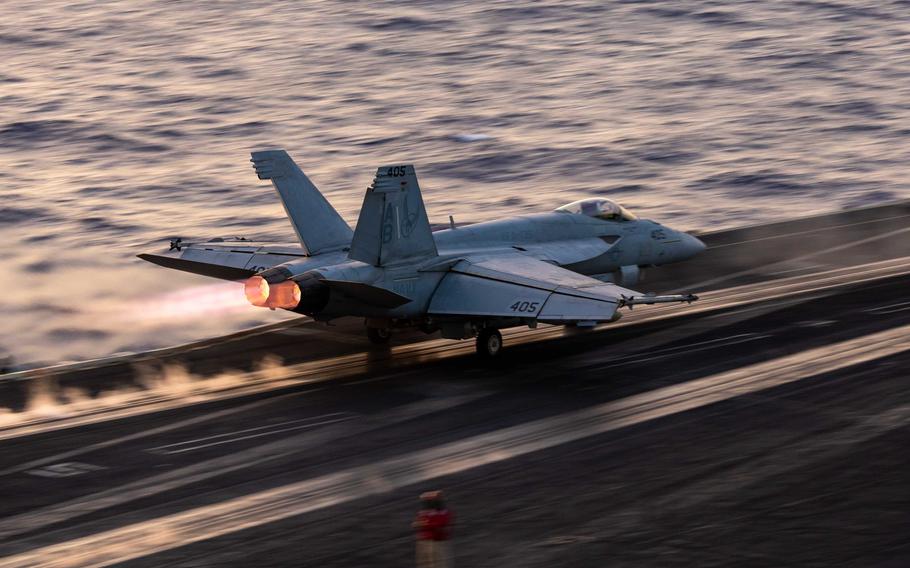
An F/A-18E Super Hornet launches from the aircraft carrier USS Harry S. Truman in the Red Sea on April 28, 2025. (Madelyn Cuevas/U.S. Navy)
Just months after Congress appropriated hundreds of millions of dollars to accelerate the Navy’s next-generation fighter, senior defense officials are pushing to delay the F/A‑XX program by up to three years — and shift critical funding to the Air Force instead.
Let me be clear: that decision would be a serious mistake. It would weaken our Navy, undermine U.S. deterrence in the Pacific, and put American lives and strategic credibility at risk.
As a Navy veteran, I’ve flown with and served alongside the men and women who depend on the power and reach of our carrier air wings. As the representative for Virginia’s 2nd Congressional District — home to Naval Air Station Oceana, the East Coast’s master jet base — I know exactly what’s at stake. The F/A‑XX is not just a replacement for the aging F/A‑18 Super Hornet. It is the centerpiece of sixth-generation naval aviation — a stealthy, long-range, data-integrated platform designed to dominate in contested environments.
It is built for the fight we know is coming.
China is already flight-testing advanced stealth aircraft it claims are sixth-generation fighters. Beijing’s military buildup is no secret — it is deliberate, well-funded, and focused on one objective: eroding America’s ability to project power in the Indo-Pacific. The aircraft carrier remains our most visible and flexible means of global presence, but without a fighter that can survive and strike in a high-end fight, the carrier air wing risks becoming outdated.
Congress understood this when we appropriated $453 million in the FY2025 defense budget to accelerate F/A‑XX — and again when we included $500 million more in the House-passed reconciliation package, often called the “Big Beautiful Bill.” The Senate Armed Services Committee has gone even further, recommending an additional $750 million to push development forward.
Yet reports now indicate that the Pentagon wants to divert those funds and postpone a contract award until 2028. That delay risks forcing a re-competition, restructuring the acquisition timeline, and ultimately breaking faith with Congress and the warfighters this program is meant to serve.
We must not allow that to happen.
Delaying F/A‑XX would open a dangerous capability gap in the 2030s, just as our adversaries are peaking in strength. Many of the F/A‑18 Super Hornets in service today have been flying for over three decades. Their ability to penetrate advanced air defenses — or survive in a near-peer conflict — is increasingly at risk.
F/A‑XX is not a “nice to have.” It’s a strategic necessity.
And it’s not just about the Indo-Pacific. Whether it’s deterring Iranian aggression in the Gulf, countering Russian influence in the Arctic, or maintaining freedom of navigation in global sea lanes, our Navy must be able to go anywhere, anytime — with a modern, lethal and survivable air wing.
Some skeptics argue that the age of manned aircraft is ending. I disagree. In a future fight where communications may be jammed, satellites disabled, and autonomous systems compromised, we will still need a pilot in the cockpit making real-time decisions. The F/A‑XX is being designed to integrate with unmanned systems, not replace them — to lead formations of autonomous wingmen, fuse targeting data, and command the battlespace.
This program is about more than just aircraft. It’s about the future of naval aviation, the credibility of U.S. deterrence, and the safety of the service members we send into harm’s way.
Congress has already made its position clear: we funded it, we support it, and we expect it to move forward without delay. The secretary of defense owes the American people answers — and results.
The world is watching. Our allies are watching. And so are our adversaries. The Navy’s future — and America’s credibility — rides on platforms like the F/A-XX. It’s time to move forward, not back.
Jen Kiggans, a Republican, represents Virginia’s 2nd Congressional District in the U.S. House of Representatives.